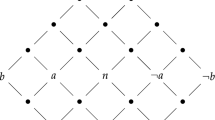Abstract
Various representation results have been established for logics of belief revision, in terms of remainder sets, epistemic entrenchment, systems of spheres and so on. In this paper I present another representation for logics of belief revision, as an algebra of theories. I show that an algebra of theories, enriched with a set of rejection operations, provides a suitable algebraic framework to characterize the theory change operations of systems of belief revision. The theory change operations arise as power operations of the conjunction and disjunction connectives of the underlying logic.
Similar content being viewed by others
References
Alchourrón, C.E. and Makinson, D., 1981, “New studies in deontic logic,” pp. 125–148 in New Studies in Deontic Logic, R. Hilpinen, ed., Dordrecht: Reidel.
Alchourrón, C.E., Gärdenfors, P., and Makinson, D., 1985, “On the logic of theory change: Partial meet functions for contraction and revision,” Journal of Symbolic Logic 50, 510–530.
Brink, C. and Heidema, J., 1989, “A verisimilar ordering of propositional theories: The infinite case,” Technical Report, TR-ARP-1/89, Research School of Social Sciences, Australian National University.
Brink, C. and Rewitzky, I., 1999, Power Structures and Program Semantics, Studies in Logic, Language and Information, Stanford, CA: CLSI.
Fuhrmann, A. and Hansson, S.O., 1994, “A survey of multiple contractions,” Journal of Logic, Language, and Information 3, 39–76.
Gärdenfors, P., 1984, “Epistemic importance and minimal changes of belief,” Australasian Journal of Philosophy 62, 136–157.
Gärdenfors, P., 1988, Knowledge in Flux: Modelling the Dynamics of Epistemic States, Cambridge, MA: MIT Press.
Gärdenfors, P. and Makinson, D., 1988, “Revisions of knowledge systems using epistemic entrenchment,” pp. 83–95 in Proceedings of the Second Conference on Theoretical Aspects of Reasoning about Knowledge, M. Vardi, ed., Los Altos, CA: Morgan Kaufmann.
Grove, A., 1988, “Two modellings for theory change,” Journal of Philosophical Logic 17, 157–170.
Hansson, S.O., 1989, “New operators for theory change,” Theoria 55, 114–132.
Katsuno, H. and Mendelzon, A.O., 1991, “Knowledge base revision and minimal change,” Artificial Intelligence 52, 263–294.
Katsuno, H. and Mendelzon, A.O., 1992, “On the difference between updating a knowledge base and revising it,” pp. 183–203 in Belief Revision, P. Gärdenfors, ed., Cambridge: Cambridge University Press.
Tarski, A., 1956, “Foundations of the calculus of systems,” pp. 342–383 in Logic, Semantics, Metamathematics: Papers from 1923 to 1938, A. Tarski, ed., J.H. Woodger, trans., London: Oxford University Press.
Author information
Authors and Affiliations
Rights and permissions
About this article
Cite this article
Britz, K. A Power Algebra for Theory Change. Journal of Logic, Language and Information 8, 429–443 (1999). https://doi.org/10.1023/A:1008374520572
Issue Date:
DOI: https://doi.org/10.1023/A:1008374520572



